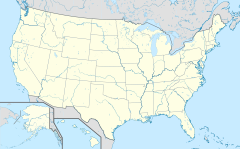Canyons of the Ancients National Monument
| Canyons of the Ancients National Monument | ||
|---|---|---|
| Remains of an observation tower in the canyon | ||
|
|
||
| Location: | Colorado , United States | |
| Next city: | Cortez | |
| Surface: | 663.2 km² | |
| Founding: | June 9, 2000 | |
| Visitors: | 75,140 (2005) | |
The Canyons of the Ancients National Monument is located in southwest Colorado in the United States . It is administered by the Bureau of Land Management , which in turn reports to the Ministry of the Interior . It was established by a decision of President Bill Clinton on June 9, 2000 and encloses three of the four separate areas of the Hovenweep National Monument , which is administered by the National Park Service . The monument contains the largest number of archaeological sites in the United States, of which over 6,000 existed in 2005.
history
Human traces in the park can be traced back over 10,000 years. The first settlements come from Paleo-Indians , who probably only used the current park for hunting and were only temporarily settled in the area as nomads . The settlements that take place after about 8000 years are attributed to the Anasazi Indians. The Anasazi built pueblo- like dwellings, which ultimately formed entire villages and city centers. The Anasazi left the area around 1300 for unknown reasons. It was probably a combination of a lengthy drought combined with armed conflict that forced the Anasazi to give up their settlements. Most of the stone houses excavated so far are attributed to them. Ute and Navajo were only to be found in the park for short periods . Spanish missionaries reported about their encounters with these two Indian tribes around 1700. But only large finds of iron ore, which was valuable at the time, led to permanent settlement by whites around 1830.
Excavations
More than 6,000 archaeological sites exist in this area and thus represent the highest density of excavations in the United States. The range of the finds ranges from simple huts to entire pueblo towns. The largest settlement comprises more than 420 rooms and over 90 kivas , an extremely large kiva and a central square. Stone towers were found all over the area, which probably served as observation posts. Numerous caverns with a sophisticated irrigation system with artificial canals were also discovered. Numerous remains of dams for water regulation were found in river basins. Countless petroglyphs have been cataloged in the park.
resources
The Bureau of Land Management manages this national monument and regulates the use of natural resources. 85% of the area is used by ranchers and the oil industry. The latter in particular endangers the archaeological remains through intensive use of resources, road construction and the development of new oil wells. Deep blasting to seismically locate new oil and gas deposits is damaging some pueblos. Intensive road construction and the easy, uncontrolled access means that intentional and unintentional vandalism is taking place more and more frequently.
Flora and fauna
The area is home to many lizards and snakes. But there are also many hunting birds such as peregrine falcons , golden eagles , colored falcons and buzzards that make their home here. Mammals such as mule deer , foxes and bobcats are rarely seen.



